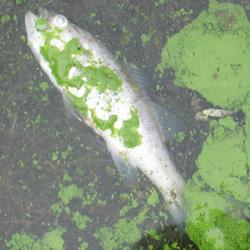Cyanobacteria from 2016 Lake Okeechobee Harmful Algal Bloom Photo-Documented
Microscope Image of Dolichospermum Circinale Cyanobacteria
Cyanobacterial Bloom on Lake Okeechobee in 2016
New report provides photographic documentation and identification of the cyanobacteria present in Lake Okeechobee, the Caloosahatchee River, and St. Lucie Canal during an extensive algal bloom in 2016.
Harmful algal blooms (HABs) include numerous species of algae and bacteria including cyanobacteria, which are also known as blue-green algae. HABs produced by cyanobacteria (cyanoHABs) pose a range of health risks to humans, wildlife and companion animals.

Lake Okeechobee, the largest inland lake in Florida frequently experiences HABs. Starting May 2016, there was an extensive cyanoHAB in Lake Okeechobee, which didn't start to dissipate untill the end of July. High water levels during that time resulted in transport of algal-laden water from the lake to coastal areas through a series of canals and rivers, which resulted in beach closures in several Florida counties.
While the algal blooms have been observed in the lake, little is known about the types of algae present during the blooms. It is important to understand the composition of the algal community, as some cyanobacteria can produce a variety of cyanotoxins, including neurotoxins and hepatotoxins such as anatoxins, cylindrospermopsins, and saxitoxins, in addition to microcystins and other potentially harmful metabolites.
In this study, scientists collected samples prior to, during, and after the extensive 2016 cyanoHAB event in Lake Okeechobee. The study report provides digital photographic documentation and taxonomic assessment of the cyanobacteria present in study samples. The majority of the images were of live organisms, allowing capture of their natural pigmentation.
Scientists identified 28 different types of algae in Lake Okeechobee, the Caloosahatchee River and the St. Lucie Canal. In addition to the dominant organism, Microcystis aeruginosa, several other cyanobacteria known to produce toxins were present at lower numbers.
This study is part of a larger effort of the U.S. Geological Survey (USGS) Environmental Health Mission Area to provide information that will help land managers to understand how to effectively minimize potential risks to the health of humans and other organisms exposed to cyanotoxins and other biogenic toxins through recreational, drinking water, and other exposure routes.
This study was funded by the USGS Priority Ecosystem Study Program and the USGS Environmental Health Program (Contaminant Biology and Toxic Substances Hydrology Program).
See below for related research.
Toxins and Harmful Algal Blooms Science Team
Satellite Data Used to Estimate and Rank Cyanobacterial Bloom Magnitude in Florida and Ohio Lakes—Developing Tools to Protect Human and Wildlife Health from Cyanotoxin Exposure
Mixtures of Algal Toxins Present Prior to and After Formation of Visible Algal Blooms—Science to Inform the Timing of Algal Toxin Exposure
Understanding Drivers of Cyanotoxin Production in the Lake Okeechobee Waterway
Understanding Associations between Mussel Productivity and Cyanotoxins in Lake Erie
New Method Developed to Quantify Spatial Extent of Cyanobacterial Blooms
Satellite Imagery Used to Measure Algal Bloom Frequency—Steps Toward Understanding Exposure Risk
Evaluating Linkages Between Algal Toxins and Human Health
Cyanobacteria of the 2016 Lake Okeechobee and Okeechobee Waterway harmful algal bloom
New report provides photographic documentation and identification of the cyanobacteria present in Lake Okeechobee, the Caloosahatchee River, and St. Lucie Canal during an extensive algal bloom in 2016.
Harmful algal blooms (HABs) include numerous species of algae and bacteria including cyanobacteria, which are also known as blue-green algae. HABs produced by cyanobacteria (cyanoHABs) pose a range of health risks to humans, wildlife and companion animals.

Lake Okeechobee, the largest inland lake in Florida frequently experiences HABs. Starting May 2016, there was an extensive cyanoHAB in Lake Okeechobee, which didn't start to dissipate untill the end of July. High water levels during that time resulted in transport of algal-laden water from the lake to coastal areas through a series of canals and rivers, which resulted in beach closures in several Florida counties.
While the algal blooms have been observed in the lake, little is known about the types of algae present during the blooms. It is important to understand the composition of the algal community, as some cyanobacteria can produce a variety of cyanotoxins, including neurotoxins and hepatotoxins such as anatoxins, cylindrospermopsins, and saxitoxins, in addition to microcystins and other potentially harmful metabolites.
In this study, scientists collected samples prior to, during, and after the extensive 2016 cyanoHAB event in Lake Okeechobee. The study report provides digital photographic documentation and taxonomic assessment of the cyanobacteria present in study samples. The majority of the images were of live organisms, allowing capture of their natural pigmentation.
Scientists identified 28 different types of algae in Lake Okeechobee, the Caloosahatchee River and the St. Lucie Canal. In addition to the dominant organism, Microcystis aeruginosa, several other cyanobacteria known to produce toxins were present at lower numbers.
This study is part of a larger effort of the U.S. Geological Survey (USGS) Environmental Health Mission Area to provide information that will help land managers to understand how to effectively minimize potential risks to the health of humans and other organisms exposed to cyanotoxins and other biogenic toxins through recreational, drinking water, and other exposure routes.
This study was funded by the USGS Priority Ecosystem Study Program and the USGS Environmental Health Program (Contaminant Biology and Toxic Substances Hydrology Program).
See below for related research.









